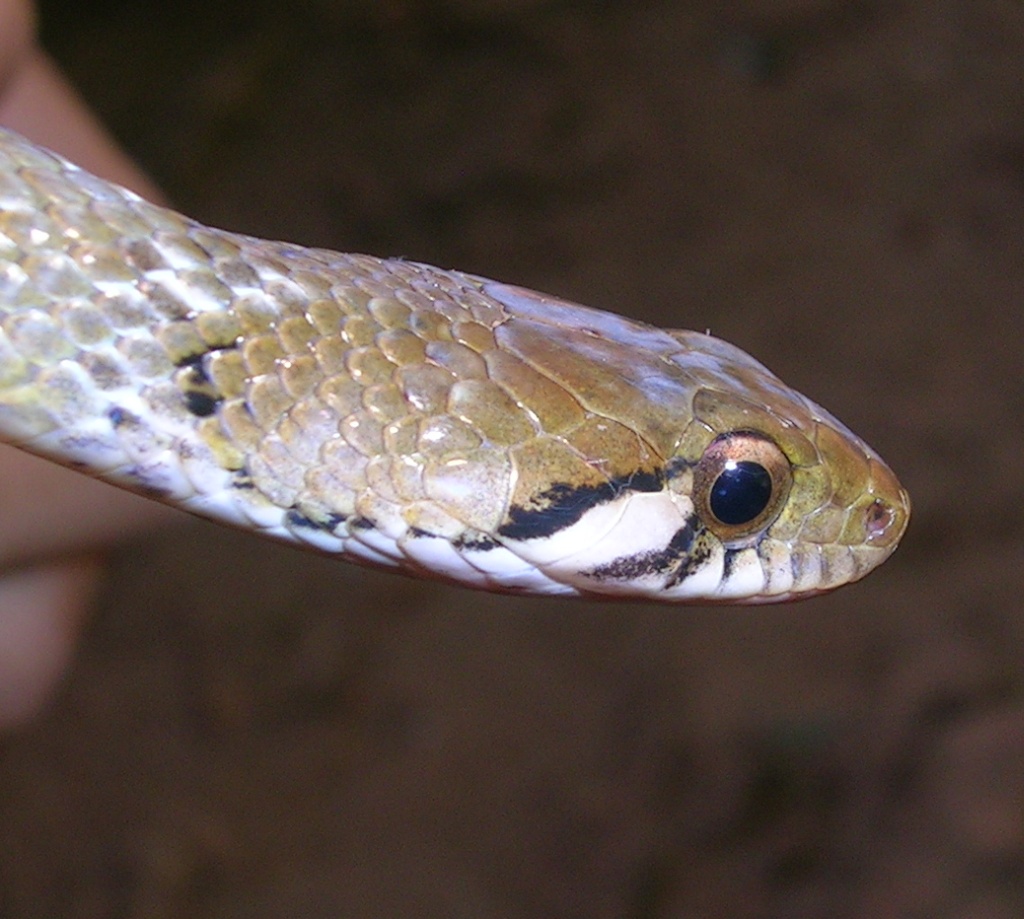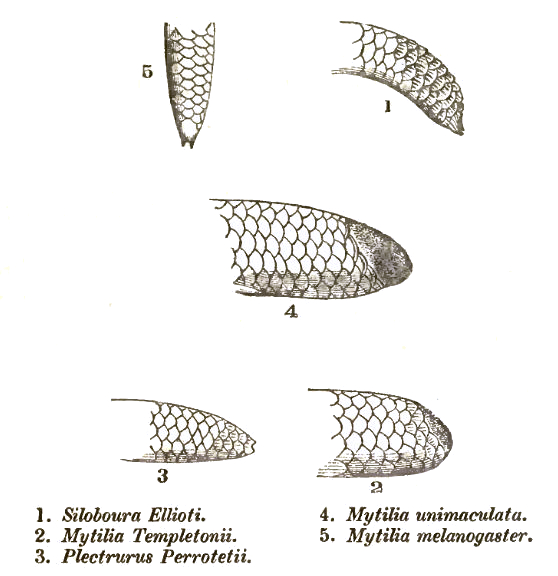|
Melanophidium Wynaudense
''Melanophidium wynaudense'', commonly known as the Indian black earth snake, is a species of snake in the family Uropeltidae. The species is endemic to India. Geographic range ''M. wynaudense'' is found in the Western Ghats of southern India India, officially the Republic of India (Hindi: ), is a country in South Asia. It is the seventh-largest country by area, the second-most populous country, and the most populous democracy in the world. Bounded by the Indian Ocean on the so .... Type locality: "Cherambady in the Wynaud Wayanad.html"_;"title="_Wayanad">_Wayanad. _Description Beddome_(1864:_180)_described_''M._wynaudense''_as_follows: "Scales_round_the_body_15,_round_the_neck_16_or_17;_rostral_scarcely_produced_back_between_the_nasals;_no_supraorbital;_muzzle_more_obtuse_than_in_''P._perrotteti'';_eye_small;_subcaudals_11_pairs;_anal_large,_bifid;_tail_compressed;_scales_smooth,_terminal_spinose,_tail_ending_in_a_single_horny_point. Colour_bluish_black,_with_broad ... [...More Info...] [...Related Items...] OR: [Wikipedia] [Google] [Baidu] |
Richard Henry Beddome
Colonel Richard Henry Beddome (11 May 1830 – 23 February 1911) was a British military officer and naturalist in India, who became chief conservator of the Madras Forest Department. In the mid-19th century, he extensively surveyed several remote and then-unexplored hill ranges in Sri Lanka and south India, including those in the Eastern Ghats such as Yelandur, Kollegal, Shevaroy Hills, Yelagiri, Nallamala Hills, Visakhapatnam hills, and the Western Ghats such as Nilgiri hills, Anaimalai hills, Agasthyamalai Hills and Kudremukh. He described many species of plants, amphibians, and reptiles from southern India and Sri Lanka, and several species from this region described by others bear his name. Early life Richard was the eldest son of Richard Boswell Brandon Beddome, solicitor, of Clapham Common, S.W. He was educated at Charterhouse School and trained for the legal profession, but preferred to join the East India Company at the age of 18 and joined the 42nd Madras ... [...More Info...] [...Related Items...] OR: [Wikipedia] [Google] [Baidu] |
Ex Errore
This is a list of terms and symbols used in scientific names for organisms, and in describing the names. For proper parts of the names themselves, see List of Latin and Greek words commonly used in systematic names. Note that many of the abbreviations are used with or without a stop. Naming standards and taxonomic organizations and their codes and taxonomies * ICTV – International Committee on Taxonomy of Viruses * ICSP – International Committee on Systematics of Prokaryotes ** formerly the ICSB – International Committee on Systematic Bacteriology ** publishes the ICNP – International Code of Nomenclature of Prokaryotes *** formerly the International Code of Nomenclature of Bacteria (ICNB) or Bacteriological Code (BC) * ICZN – International Commission on Zoological Nomenclature ** publishes ''ICZN'' the ''International Code of Zoological Nomenclature'' or "ICZN Code" * IBC – International Botanical Congress ** publishes ''ICN'' the ''International Code of Nomenclature ... [...More Info...] [...Related Items...] OR: [Wikipedia] [Google] [Baidu] |
Albert Günther
Albert Karl Ludwig Gotthilf Günther FRS, also Albert Charles Lewis Gotthilf Günther (3 October 1830 – 1 February 1914), was a German-born British zoologist, ichthyologist, and herpetologist. Günther is ranked the second-most productive reptile taxonomist (after George Albert Boulenger) with more than 340 reptile species described. Early life and career Günther was born in Esslingen in Swabia (Württemberg). His father was a ''Stiftungs-Commissar'' in Esslingen and his mother was Eleonora Nagel. He initially schooled at the Stuttgart Gymnasium. His family wished him to train for the ministry of the Lutheran Church for which he moved to the University of Tübingen. A brother shifted from theology to medicine, and he, too, turned to science and medicine at Tübingen in 1852. His first work was "''Ueber den Puppenzustand eines Distoma''". He graduated in medicine with an M.D. from Tübingen in 1858, the same year in which he published a handbook of zoology for students of ... [...More Info...] [...Related Items...] OR: [Wikipedia] [Google] [Baidu] |
George Albert Boulenger
George Albert Boulenger (19 October 1858 – 23 November 1937) was a Belgian-British zoologist who described and gave scientific names to over 2,000 new animal species, chiefly fish, reptiles, and amphibians. Boulenger was also an active botanist during the last 30 years of his life, especially in the study of roses. Life Boulenger was born in Brussels, Belgium, the only son of Gustave Boulenger, a Belgian public notary, and Juliette Piérart, from Valenciennes. He graduated in 1876 from the Free University of Brussels with a degree in natural sciences, and worked for a while at the Royal Belgian Institute of Natural Sciences, Brussels, as an assistant naturalist studying amphibians, reptiles, and fishes. He also made frequent visits during this time to the ''Muséum national d'Histoire naturelle'' in Paris and the British Museum in London. In 1880, he was invited to work at the Natural History Museum, then a department of the British Museum, by Dr. Albert C. L. G. Günt ... [...More Info...] [...Related Items...] OR: [Wikipedia] [Google] [Baidu] |
Malcolm Arthur Smith
Malcolm Arthur Smith (1875 in New Malden, Surrey – 1958 in Ascot) was a herpetologist and physician working in the Malay Peninsula. Early life Smith was interested in reptiles and amphibians from an early age. After completing a degree in medicine and surgery in London in 1898, he left for the then Kingdom of Siam (today Thailand) as a doctor to the British Embassy in Bangkok. In 1921 he married Eryl Glynne of Bangor, who as well as being medically trained, made significant collections of ferns from Thailand and later worked at RBG Kew. She was killed in a car crash near Bangkok in 1930. The couple had three children including the mountaineer Cymryd "Cym" Smith, also killed in a road accidenEryl was the elder sister of the mountaineer and plant pathologist Mary Dilys Glynne. Work Smith went on to become the physician in the royal court of Siam and was a close confidant and a doctor to the royal family. He published his observations on the reptiles and amphibians during his ... [...More Info...] [...Related Items...] OR: [Wikipedia] [Google] [Baidu] |
Ernest Edward Williams
Ernest Edward Williams (January 7, 1914 – September 1, 1998) was an American herpetologist. He coined the term '' ecomorph'' based on his research on anoles. Taxa named in honor of Ernest E. Williams The following species are named in honor of Ernest E. Williams. Beolens, Bo; Watkins, Michael; Grayson, Michael (2011). ''The Eponym Dictionary of Reptiles''. Baltimore: Johns Hopkins University Press. xiii + 296 pp. . ("Eew", p. 81; "Ernest", p. 85; "Williams, E.E.", p. 286; "Williams-Mittermeier", p. 287). *'' Lygodactylus williamsi'' *''Anolis eewi'' (synonym of '' Anolis planiceps'') *''Erythrolamprus williamsi'' *'' Strophurus williamsi'' *''Pelusios williamsi'' *''Dipsas williamsi'' *''Anolis ernestwilliamsi'' *''Phrynops williamsi'' *'' Sphaerodactylus williamsi'' *'' Lepidoblepharis williamsi'' *'' Cynisca williamsi'' *''Pristimantis ernesti'' *''Anolis williamsmittermeierorum'' Taxa described by Ernest E. Williams *''Aldabrachelys'' *'' Anolis anchicayae'' ... [...More Info...] [...Related Items...] OR: [Wikipedia] [Google] [Baidu] |
Species
In biology, a species is the basic unit of classification and a taxonomic rank of an organism, as well as a unit of biodiversity. A species is often defined as the largest group of organisms in which any two individuals of the appropriate sexes or mating types can produce fertile offspring, typically by sexual reproduction. Other ways of defining species include their karyotype, DNA sequence, morphology, behaviour or ecological niche. In addition, paleontologists use the concept of the chronospecies since fossil reproduction cannot be examined. The most recent rigorous estimate for the total number of species of eukaryotes is between 8 and 8.7 million. However, only about 14% of these had been described by 2011. All species (except viruses) are given a two-part name, a "binomial". The first part of a binomial is the genus to which the species belongs. The second part is called the specific name or the specific epithet (in botanical nomenclature, also sometimes i ... [...More Info...] [...Related Items...] OR: [Wikipedia] [Google] [Baidu] |
Family (biology)
Family ( la, familia, plural ') is one of the eight major hierarchical taxonomic ranks in Linnaean taxonomy. It is classified between order and genus. A family may be divided into subfamilies, which are intermediate ranks between the ranks of family and genus. The official family names are Latin in origin; however, popular names are often used: for example, walnut trees and hickory trees belong to the family Juglandaceae, but that family is commonly referred to as the "walnut family". What belongs to a family—or if a described family should be recognized at all—are proposed and determined by practicing taxonomists. There are no hard rules for describing or recognizing a family, but in plants, they can be characterized on the basis of both vegetative and reproductive features of plant species. Taxonomists often take different positions about descriptions, and there may be no broad consensus across the scientific community for some time. The publishing of new data and opin ... [...More Info...] [...Related Items...] OR: [Wikipedia] [Google] [Baidu] |
Uropeltidae
The Uropeltidae, also known commonly as the shieldtails or the shield-tailed snakes, are a family of primitive, nonvenomous, burrowing snakes native to peninsular India and Sri Lanka. The name is derived from the Greek words ('tail') and ('shield'), indicating the presence of the large keratinous shield at the tip of the tail. Seven or eight genera are recognized, depending on whether '' Teretrurus rhodogaster'' is treated in its own genus or as part of ''Brachyophidium''. The family comprises over 50 species. These snakes are not well known in terms of their diversity, biology, and natural history. Description Snakes in the family Uropeltidae are small snakes, with adults growing to a total length (including tail) of . They are adapted to a fossorial way of life, which is apparent in their anatomy. The skull is primitive and inflexible, with a short, vertical quadrate bone and rigid jaws; the coronoid bone is still present in the lower jaw. The orbital bones are absent, th ... [...More Info...] [...Related Items...] OR: [Wikipedia] [Google] [Baidu] |
Endemism
Endemism is the state of a species being found in a single defined geographic location, such as an island, state, nation, country or other defined zone; organisms that are indigenous to a place are not endemic to it if they are also found elsewhere. For example, the Cape sugarbird is found exclusively in southwestern South Africa and is therefore said to be ''endemic'' to that particular part of the world. An endemic species can be also be referred to as an ''endemism'' or in scientific literature as an ''endemite''. For example '' Cytisus aeolicus'' is an endemite of the Italian flora. '' Adzharia renschi'' was once believed to be an endemite of the Caucasus, but it was later discovered to be a non-indigenous species from South America belonging to a different genus. The extreme opposite of an endemic species is one with a cosmopolitan distribution, having a global or widespread range. A rare alternative term for a species that is endemic is "precinctive", which applies t ... [...More Info...] [...Related Items...] OR: [Wikipedia] [Google] [Baidu] |
India
India, officially the Republic of India (Hindi: ), is a country in South Asia. It is the seventh-largest country by area, the second-most populous country, and the most populous democracy in the world. Bounded by the Indian Ocean on the south, the Arabian Sea on the southwest, and the Bay of Bengal on the southeast, it shares land borders with Pakistan to the west; China, Nepal, and Bhutan to the north; and Bangladesh and Myanmar to the east. In the Indian Ocean, India is in the vicinity of Sri Lanka and the Maldives; its Andaman and Nicobar Islands share a maritime border with Thailand, Myanmar, and Indonesia. Modern humans arrived on the Indian subcontinent from Africa no later than 55,000 years ago., "Y-Chromosome and Mt-DNA data support the colonization of South Asia by modern humans originating in Africa. ... Coalescence dates for most non-European populations average to between 73–55 ka.", "Modern human beings—''Homo sapiens''—originated in Africa. Then, interm ... [...More Info...] [...Related Items...] OR: [Wikipedia] [Google] [Baidu] |




.jpg)